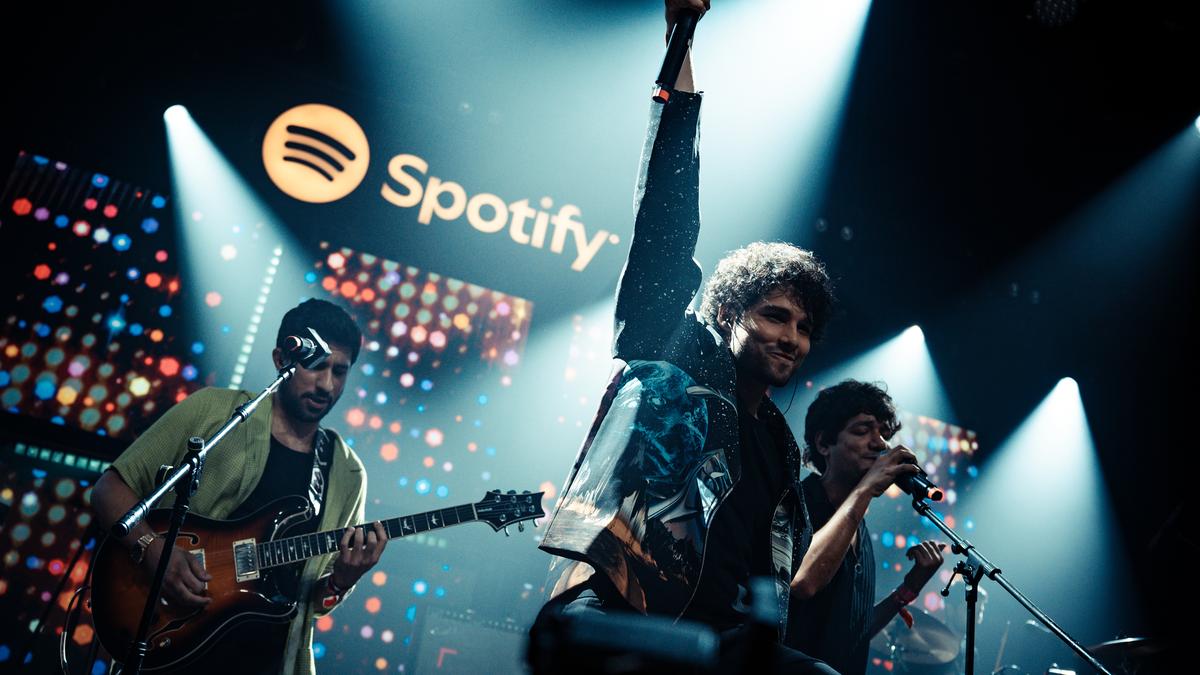OAFF x Savera presenting their latest single ‘Ittefaq’ with Siddhanth Chaturvedi | Photo Credit: Special Arrangement
The crowd at the brick-built, peaked-roofed Snowball Studios in Mumbai’s Worli invites some curious questions. “What’s going on here? Is this an audition?” asks a passerby. No. In fact, there’s a long line of young (mostly Gen Z) spectators waiting to get in on the indie music showcase. A few hours later, an excited Siddhant Chaturvedi on stage sang excerpts from his latest single ‘Ittefaq’, created in collaboration with OAFF x Savera, to hoots, shrieks and applause. His surprise arrival was preceded by independent performances by alternative musicians from different parts of the country.
It is nothing new that Mumbai has a dedicated audience for homegrown, indie music. At Spotify’s recent showcase, which celebrated four years of their global emerging artists programme Radar, indie music, spanning various genres and languages, took centre stage. The line-up included Boys From Mars (Himachal Pradesh), Burrah (Delhi), Marshall Robinson (Chennai), Hansika Pareek (Ajmer), Swastik The Band (Chandigarh), Ranj x Cliffor (Chennai/Bengaluru) and more.

Dhruvank Vaidya, Head of Music and Podcasts, Spotify India, says, “RADAR is a global program spanning across multiple countries and four years ago, we brought it to India as well. It is to support emerging artists. While everyone knows the big stars, emerging artists find it difficult to break through. Supporting them is also very important for the growth of the music industry.” From 2020 till date, RADAR India has featured over 40 emerging artists. Apart from having playlists, the program also includes an ‘artist of the month’ who appears on the playlist cover, and being a part of their live performances which increases their visibility.

RANJ X CLIFFER | Photo Credit: Yash Pardeshi
Visible trends
When Spotify launched in India, 70% of the music streamed was international music. Today, more than 70% of the music streamed is local. Within this space, as indie music continues to grow across genres and languages, the number of listeners of non-film music has also increased. Dhruvank says millennial and Gen Z listeners are eager to experiment and explore. Last year alone, RADAR India discovered 2.4 million new user-artists.
Dhruvank says, “There are a lot of artistes now who are more confident in putting out music. Access has been democratised. Now, an emerging artiste doesn’t have to rely on just making music videos. Even if they have just one audio track, they can upload it and build an audience. From a financial perspective, it works for them. Another big trend we are seeing is that short video platforms create visibility and then consumption on Spotify.”

Having performed at over 300 colleges, Swastik The Band, a classical and alternative rock collective formed in 2011, is in the midst of a changing music ecosystem. Lead guitarist Rohit Joshi says that while the audience is evolving, artists need to be honest about the music they create. He adds, “I think music is a cycle, it repeats itself after a few years and making music that only belongs to that particular time period doesn’t do justice to the sound.”
Dhruvank believes that Indian listeners generally prefer listening to music in two languages.

Swastik The Band | Photo Credit: Yash Pardeshi
When Radar India started, the main focus was on Hindi and English. “But we noticed that there are a large number of non-film actors in other languages too,” says Dhruvank. Last year, a chapter in Tamil was launched, while this year Punjabi is also being discussed.
Punjabi pop artist Burrah’s music overcomes the hyper-masculine feel associated with Punjabi music and reveals a softer, relatable side that addresses mental health. “I have always been thinking about how I can bring a change to Punjabi music. It’s a journey I’m still on,” says Jasdeep Singh aka Burrah. Though he initially felt the language might be a barrier to breaking into the mainstream, his track ‘Sochi Jawaan’, which hit No. 1 in Guwahati, overcame this misconception. “It was really special for a song about depression in Punjabi to get such a reception. People understand the energy BuddyBurah asks, “How else would ‘Despacito’ have become such a huge global hit?”

Punjabi artist Burrah | Photo Credit: Special Arrangement
